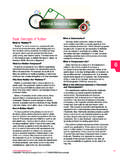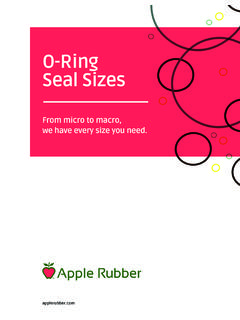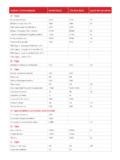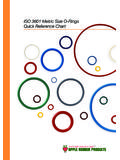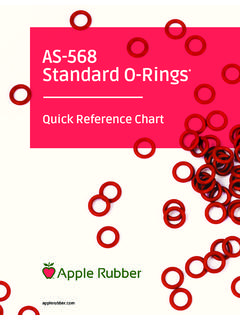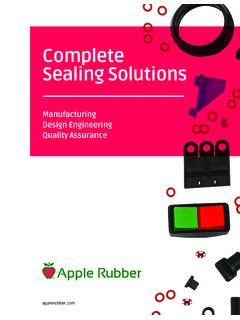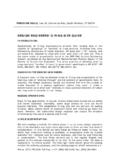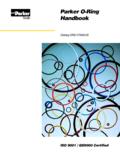Transcription of 4 Seal Types & Gland Design - Apple Rubber
1 seal Types & Gland Design411 Major Classifications All O- ring seal applications are categorized in terms of relative motion. In situations involving little or no motion relative to the seal , the O- ring application is STATIC. In situations involving reciprocating, rotating, or oscillating motion relative to the seal , the O- ring application is seal Types Static seals are categorized as either AXIAL or RADIAL, depending upon the direction in which squeeze is applied to the O- ring s cross AXIAL SEALS A static axial seal acts similar to a gasket in that it is squeezed on both the top and bottom of the O- ring s cross section.
2 This type of seal is typically employed in the face (flange) type applications, depicted in Illustration When used as a face seal involving either internal or external pressure, the O- ring should always be seated against the low pressure side of the groove (as shown in Illustration & Illustration ) so the O- ring is already where it needs to be as a result of the pressure. Static axial seals tend to be easier to Design than static radial seals. Since there is no extrusion gap, there are fewer Design steps and you can control the tolerances Axial seal Gland Dimensions: Table B, p. 18-29, lists SAE recommended dimensions for static axial seal glands by ascending AS-568* O- ring Min.
3 = O- ring Mean Max. = O- ring Mean + 1% UP TO .060 PXPPX Min. = O- ring Mean X Max. = O- ring Mean + 1% UP TO .060 Internal PressureExternal PressureY Min. = O- ring Mean - 1% UP TO .060 Y Max. = O- ring Mean *Note: The current revision of the Standard is C but it changes (US & Canada Only) + (International)STATIC RADIAL SEALS Static Radial Seals are squeezed between the inner and outer surfaces of the O- ring . They are typically employed in cap and plug type applications, as depicted in Illustration Radial seal Gland Dimensions: Table C, p. 30-41, lists SAE recommended dimensions for static radial seal glands by ascending AS-568* : Recommended dimensions for static radial seal glands listed in Table C are based on an application pressure limit of 1500 psi.
4 For higher pressure requirements reference Section 5, Illustration or contact Apple Rubber for technical CRUSH SEALS In crush seal applications, the O- ring is completely confined and pressure deformed (crushed) within a triangular Gland made by machining a 45 angle on the male cover. Squeezed at an angle to the O- ring s axis, crush seals are used in such simple applications as the one depicted in Illustration Static Crush seal Gland Dimensions: Table D, p. 42, lists SAE recommended dimensions for static crush seal glands by ascending AS-568* SEALS WITH DOVETAIL GLANDS O-rings are sometimes employed in static or slow moving dynamic situations calling for specially machined dovetail glands.
5 Because of the angles involved, controlling the tolerances in these glands may be difficult. The purpose of these glands is to securely hold the O- ring in place during machine operation and/or maintenance disassembly. A typical valve seat application is shown in Illustration 45 12 Radial SealStatic Crush SealDovetail GlandIllustration a static crush seal application, it is recommended that the O- ring volume does not exceed 95% of the Gland Thumb4*Note: The current revision of the Standard is C but it changes (US & Canada Only) + (International) seal Types & Gland Design13 In this application, O- ring squeeze is primarily axial in direction (valve operation exerts force on top and bottom seal surfaces).
6 To avoid tearing or nicking, the use of O- ring lubrication is recommended while installing the O- ring into the dovetail Gland . Because of the difficulty in creating the groove and tight tolerances required, this type of seal application should only be used when Gland Dimensions: Table E, p. 42, lists SAE recommended dimensions for dovetail glands by ascending AS-568* seal Types This classification of seals is used in situations involving reciprocating, rotating or oscillating motion. Dynamic seal performance may be substantially affected by a number of operating environmental factors. Such factors include seal swell in fluids, surface finish of hardware components, lubrication, system pressure, thermal cycling, O- ring squeeze, O- ring stretch, and friction.
7 Since many of these factors are interrelated, it is important to consider ALL of them in dynamic sealing situations. In discussions of individual dynamic seal Types , therefore, mention will be made of the most critical operating environmental factors to consider. More detailed information on Critical Operating Environmental Factors is found in Section SEALS Reciprocating seals, as depicted in Illustration , are used in situations involving a moving piston and a rod. These seals constitute the predominant dynamic application for O-rings. For optimum performance of reciprocating seals, careful consideration of the following factors is required:Compound Selection for Thermal Cycling: Thermal cycling from high (100 F and above) to low (-65 F and below) temperatures may cause O-rings to take a compression set at elevated temperatures and fail to rebound enough at low temperatures to provide a leak-proof seal .
8 Such O- ring leaks are especially prone to occur in low pressure, reciprocating applications. Therefore, when extreme operating thermal cycles are anticipated, it is recommended that you specify a seal compound that exceeds, rather than merely meets, desired temperature range, compression set, and resilience Over Pressure Shocks: With sudden stopping and holding of heavy loads, hydraulic components can create system pressures far in excess of seal extrusion resistance capabilities. To prevent extrusion and eventual O- ring failure, pressure shocks should be anticipated and effectively dealt with in both seal selection and system Design .
9 As required, mechanical brakes or pressure relief valves may have to be built into the hydraulic system. Illustration DiameterPistonGrooveDiameterBoreDiameter PistonDiameterRod DiameterPistonGrooveDiameterBoreDiameter Piston SealRod SealPistonDiameterFor reciprocating seals passing O-rings over ports is not recommended. Nibbling and premature wear and seal failure will ThumbReciprocating Seals*Note: The current revision of the Standard is C but it changes (US & Canada Only) + (International)O-RingO- ring The use of back-up rings or increased seal durometer may also be necessary to prevent O- ring extrusion. For more information on the effects of pressure, see Illustration in Section 5 of this : Listed in Table A, p.
10 17, under Gland Design at the end of this section are the recommended squeeze values for O-rings employed in reciprocating applications. Lower squeeze than that shown in Table A will reduce friction, but at a cost of possible leakage in low pressure situations. Greater squeeze than that shown will increase friction and sealing capability, but at a cost of difficult assembly, faster seal wear, and the increased potential for spiral : When the of an O- ring is stretched, the O- ring s cross section is reduced. In such instances, be sure to consider that the O- ring s reduced cross section maintains the correct percentage of seal squeeze.

